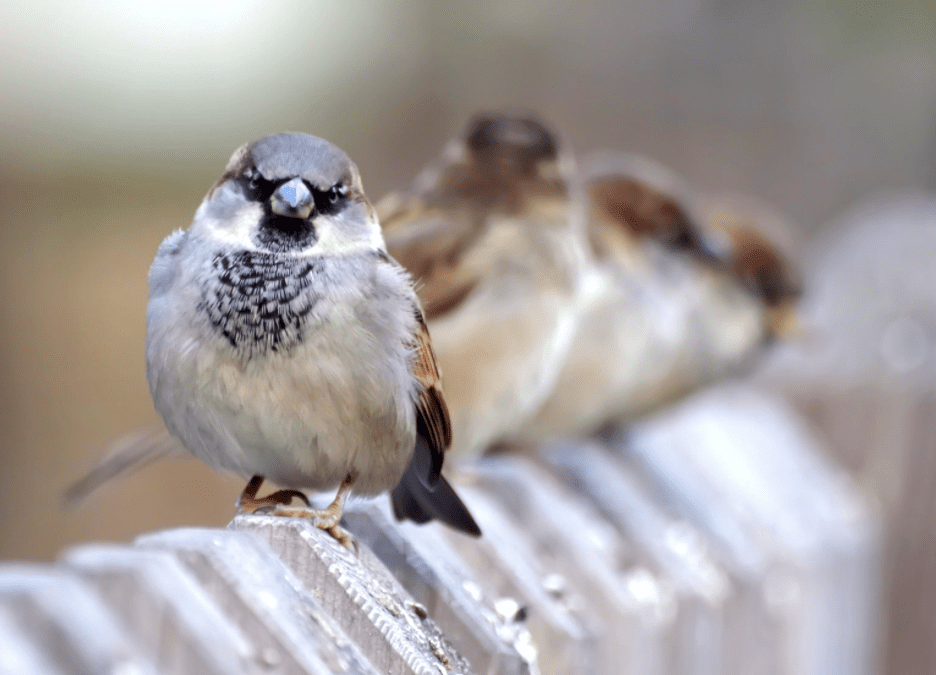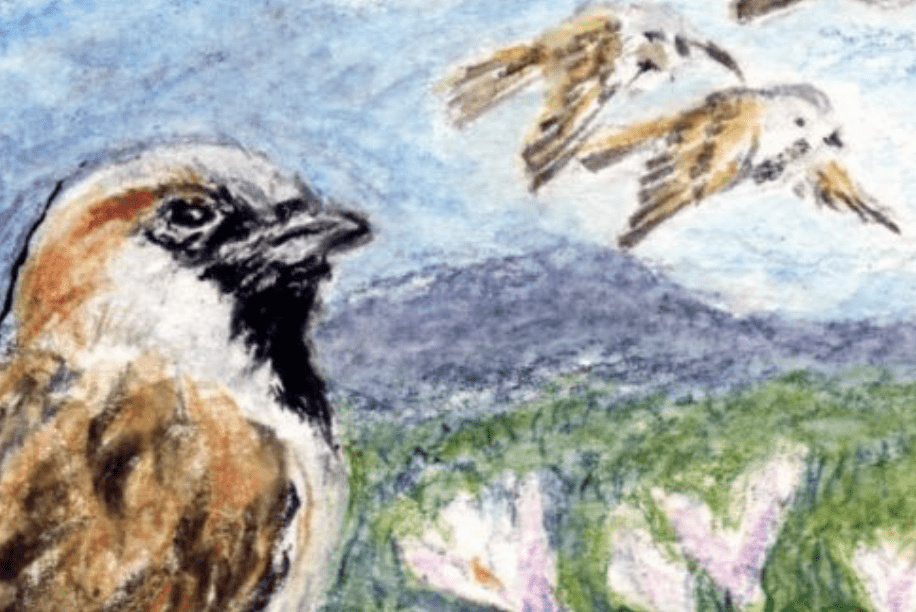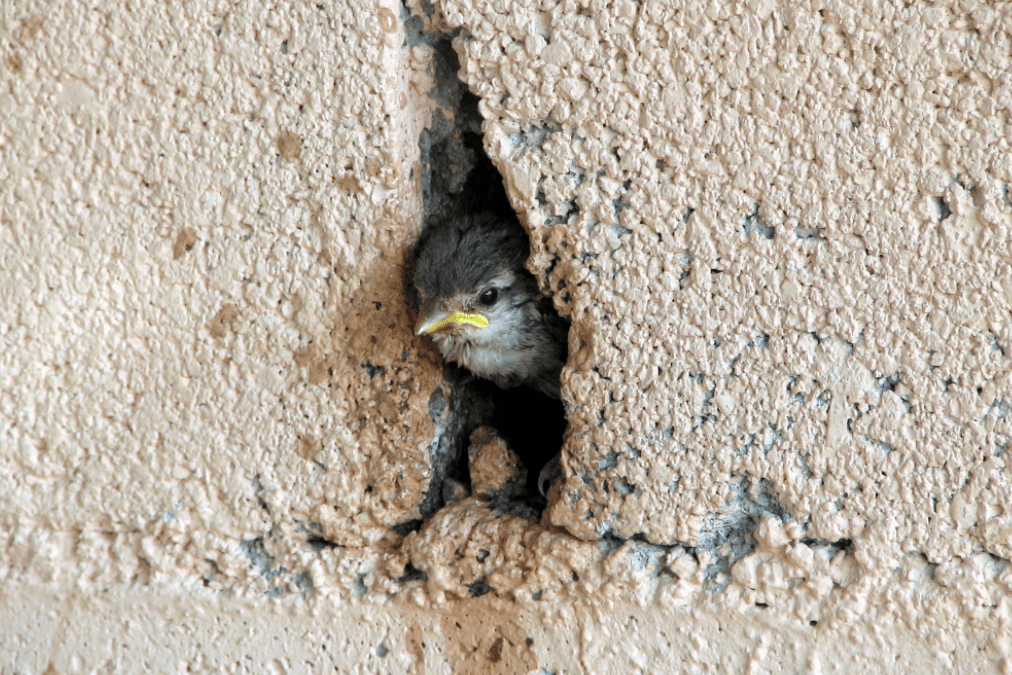
by Pigeon Patrol | Jan 14, 2021 | Bird Deterrent Products, Bird Netting, Bird Spikes, Pigeon Control, Pigeon Droppings, Pigeon Patrol's Services
It starts as a slight scratching. You suspect mice or rats at first until you hear the faint tweeting that means only one thing: A bird has become trapped behind your wall. Unfortunately, getting the bird out is a lot harder for you than it was for it to get in. Accept that it will probably mean cutting a hole in your wall. You also need to figure out where the bird got in and cover the hole with a metal screen to prevent it from happening again.
Lure It Out
Luring a bird out of a wall sounds logical. The bird got itself in, therefore it should be able to get itself out. This can work in some cases, but usually the bird becomes trapped between two walls and doesn’t have enough room to fly. If it sounds like the bird is moving up and down in the walls and you know where it entered, you can try luring it out. Place a bright light near the entrance to the wall since birds often fly toward light. Open any windows in the room and close it off to other areas of your house. Playing recorded birdsong near the entrance can help assure the bird that it is safe to come out; otherwise keep it very quiet in that room. Placing birdseed near the hole won’t work because birds have a poor sense of smell. If the bird is not out within a few hours, it probably can’t get out on its own.
Cut It Out
If you have the right tools and some construction experience, you can try to free the bird yourself by cutting a large hole in the wall above the bird. Cut shallowly into the drywall to avoid cutting into the electrical wires. Make the cut neat to make patching the wall easier. Once the piece of the wall is removed, the bird may fly out suddenly. Open any windows and doors to the outside to allow it to escape. If it doesn’t fly out, reach in with a gloved hand and carefully pick it up. Don’t release it until you are outside.
Call In an Expert
The safest, simplest method of dealing with a trapped bird is to call in a professional wildlife control expert. Look in the phone book under “pest control” or “animal removal services” to find one. Although they will charge a fee, they will get the animal out with the least amount of damage to your wall and home. In some cases, the cost of paying for animal control is less than paying a contractor to repair the damage done to your home.
Pigeon Patrol Products & Services is the leading manufacturer and distributor of bird deterrent (control) products in Canada. Pigeon Patrol products have solved pest bird problems in industrial, commercial, and residential settings since 2000, by using safe and humane bird deterrents with only bird and animal friendly solutions. At Pigeon Patrol, we manufacture and offer a variety of bird deterrents, ranging from Ultra-flex Bird Spikes with UV protection, Bird Netting, 4-S Gel and the best Ultrasonic and audible sound devices on the market today. source
Contact us at 1- 877– 4– NO-BIRD, (604) 585-9279 or visit our website at www.pigeonpatrol.ca
Pigeon / Pigeon Patrol / Pigeons Roosting / Vancouver Pigeon Patrol / Bird Control / Surrey Pigeon Control / Pest / Vancouver Pigeon Blog / Birds Inside Home / Pigeons in the cities / Ice Pigeons/ What to do about pigeons/ most common types of sparrows , Damages Caused by Sparrows, How To Keep Raccoons Away, de-fence, Pigeon Nesting and Breeding Patterns and Behavior What Do I Do With a Bird Trapped in My Wall?
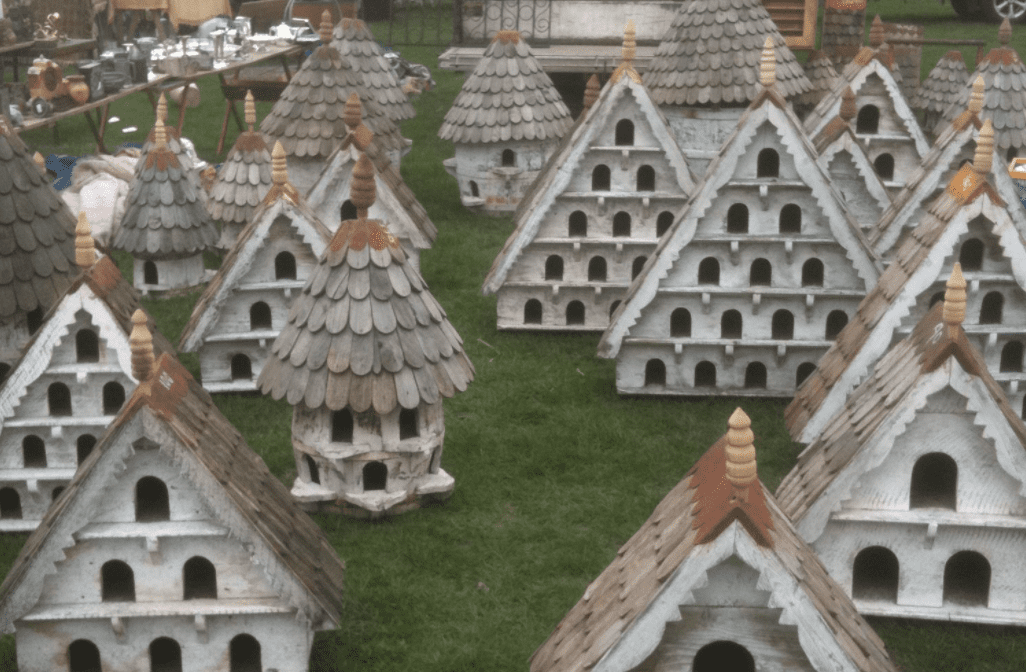
by Pigeon Patrol | Dec 27, 2020 | 4-S Gel Bird repellent, Animal Deterrent Products, Bird Deterrent Products, Bird Netting, history of pigeons, Pigeons
What Are Dovecotes?
Dovecotes, Commonly known as:
Pigeon houses, columbaria, culver houses, pigeon cotes, dove houses
A dovecote or dovecot, doocot or columbarium is a structure intended to house pigeons or doves. Dovecotes may be free-standing structures in a variety of shapes, or built into the end of a house or barn. They generally contain pigeonholes for the birds to nest.

Widcombe Manor Farm Dovecote
Dovecotes were a common sight throughout Britain and across mainland Europe between the 16th and 19th centuries, but today few remain and of those that do, many are now in ruins. Dovecotes are specially constructed pigeon houses where pigeons were kept for a variety of purposes, but in the main as a source of food. Other uses for the domesticated pigeon were as quarry for falconry and as a target for shooting matches that were common in the 19th century and in which as many as 120 birds were shot for sport in each match. Dovecotes can be constructed of virtually any material (although early dovecotes were constructed exclusively of stone) and can be free-standing structures or provided as part of an existing structure or as a ‘lean-to’ addition.

Ancient Dovecote at Embleton
The earliest dovecotes may have been introduced to Britain by the Romans based on the fact that pigeon rearing was common in Italy with dovecotes being provided close to villas and farmsteads for the purpose of food. Over half a century ago C.D. Chalmers suggested that a number of unexplained foundations on Roman sites in Britain were the remains of ancient dovecotes, but his views have never been corroborated. Due to the lack of any firm evidence that dovecotes were introduced into Britain by the Romans it is likely that it was the Normans that first introduced the dovecote and as a result domesticated the rock dove from which the feral pigeon of today is descended.
One of the earliest British examples is believed to be a 12th century dovecote that was uncovered during archaeological works in Raunds, Northamptonshire. This early dovecote is circular and commonly known as a ‘rubblestone dovecote’. A number of these early rubblestone dovecotes, dating back to the 12th and 13th centuries, have been uncovered throughout southern England in recent years and with quite a significant geographical spread ranging from Devon in the south-west through to Lincolnshire in the east. These early dovecotes were built mainly to service the culinary needs of monasteries, castles and manors but were the sole preserve of the wealthy and almost certainly beyond the means of the poor. In Medieval and Norman times the building of a dovecote was a feudal right restricted to lords of the manor, abbots and barons with these privileges eventually extending down to the humble parish priest. Today very few of these structures remain intact.

Much Marcle Dovecote
It was in the 16th century that dovecotes became popular in Britain with a huge variety of different designs and types being constructed. Ancient dovecotes are believed to be round in shape but later in the 17th century square, rectangular and octagonal dovecotes were built, some with incredibly intricate designs. Further designs and types include ‘lectern’ dovecotes, ‘in and out’ dovecotes, ‘polygon’ dovecotes and even caves have been adapted for the keeping of domesticated pigeons. Lectern dovecotes are shaped like a reading desk, hence their common name, and normally consisted of a 4-sided building with a single pitched roof with raised parapet walls on 3 sides. In and out dovecotes, sometimes known as Irish dovecotes, consisted of tiers of breeding cubicles together with perching ledges that were built into the exterior wall of a house or building. Polygon dovecotes (polygon, in this context, meaning a building with more than 5 sides) are more often than not octagonal structures ranging dramatically in size and often housing large numbers of birds. Caves, both coastal and inland, have been used to house domestic pigeons but their use is less common than the conventional dovecote.

Breeding Cubicles,
Shobdon Court Dovecote
The interior of a dovecote is usually a large open space with the breeding cubicles or ledges being offered in rows around the internal walls. Pigeons would enter the dovecote in a variety of ways, depending on the size, shape and type of structure, with the most common entry/exit point (known as the flight entrance) being provided beneath a cupola on the roof of the structure. The birds would be encouraged to roost and breed within the structure and as pigeons are quite prolific breeders, bringing up to 8 young into the world each year, competition for breeding cubicles would be high.
As the main purpose of a dovecote was to provide food, and as the pigeon squab (or chick) was seen as a delicacy, squabs would be ‘farmed’ when they achieved a certain age and size (normally 4 weeks of age). In the 16th century eating pigeon meat became much more popular with ‘pigeon pie’ becoming a delicacy and often described as ‘food fit for kings’ – this rather dispels the myth that pigeons are disease carriers! As a result of this popularisation, pigeon meat not only graced the tables of the monarchy and the rich, it became a standard food for the masses and it was commonly said that every family should eat squab at least once a week. Some squab ‘farms’ were believed to house anything from 10,000 to 30,000 birds to satisfy this demand.

Cross-section of
Classic Dovecote
In order to access breeding cubicles and remove squabs an ingenious system had to be designed based on the inaccessibility of nests and the sheer height and size of some of the larger dovecotes. For smaller dovecotes a free-standing ladder was used for access but for larger structures a ‘potence’ was used, although more commonly for round rather than square or rectangular dovecotes. The potence consisted of a large vertical wooden pole situated in the centre of the interior and which was pivoted both at the base and at the top, allowing the pole to rotate 360°. Several lateral arms were joined to the vertical post at right angles to which ladders were attached. As the main pole was rotated the lateral arms and ladders also rotated around the interior allowing access to all the breeding cubicles.

Dovecote at Godminster
Although the provision of food was the main purpose of the dovecote, there was one interesting and highly valued by-product that had a dual purpose – pigeon guano! Pigeon guano was, and still is, considered to be one of the finest fertilisers in the world and was a highly prized commodity as a result. In the Middle East (where eating pigeon flesh was forbidden) dovecotes were built simply to provide manure for growing fruit and this practice continued for centuries. In France, Italy and Spain guano was used extensively on hemp crops and for the fertilisation of vineyards and in England it was considered to be an extremely potent manure. It was often said that pigeon guano was worth 10 loads of other sorts (manure).

Dovecote at Weetwood Hall
In the 16th century pigeon guano was sought after for a different reason – it was found to contain saltpetre, which was used for the manufacture of gunpowder. This secret was brought across from Germany and sold for a payment of £300, which would have been a huge sum in those days. This dramatically changed the role of the dovecote in light of the fact that guano was potentially valued more highly than the birds themselves and to protect this resource armed guards were often placed outside dovecotes to stop thieves stealing the guano. Production of saltpetre from pigeon guano ended in the late 18th century when it was found to be naturally occurring in South America.

Dovecote at Kings Pyon
Although the commercial use of dovecotes died out in the 19th century with many magnificent examples being allowed to fall into disrepair due to neglect, they have experienced something of a re-birth in the 21st century with dovecotes being used for the control of the feral pigeon, a direct descendent of the domesticated dovecote bird. Dovecotes and pigeon lofts are now commonly used for the control of the feral pigeon in towns and cities all over the world, with the notable exception of the USA.
The principle of using a dovecote (or pigeon loft) as a pigeon control option was pioneered by the Pigeon Control Advisory Service International (PiCAS International) and can be loosely described as a form of birth control. Pigeons are encouraged into a dovecote by the provision of a dedicated public feeding area, sited immediately beside the dovecote, where the public will be asked to feed the birds at the same time as being asked to cease feeding elsewhere. Pigeons will then take up residence in the dovecote (based on the close proximity of a good reliable food source) and once breeding starts all eggs are removed, as laid, and replaced with dummy eggs. Where a pigeon loft is used for the purpose of control rather than a dovecote the facility would be sited on the roof of a building or even within the roof of a building, rather than at ground level. Pigeons would be encouraged into the loft by the provision of food and once breeding starts eggs would be removed and replaced in the same way as with a dovecote facility.

Bailiffscourt Dovecote
This humane, effective and cost effective method of control is rapidly replacing the extreme use of lethal control, commonly used to control pigeon populations in the 21st century. Schemes using dovecotes, or artificial breeding facilities as they are now commonly known, have achieved staggering results where provided as a control option, often reducing pigeon flock size by as much as 50% and in some cases by as much as 95%. Pigeons will readily use a dovecote facility for the purposes of breeding and providing that some basic rules are followed this method of control, based on a concept that is more than 1000 years old, will provide any property owner or local government body with a cheap, popular and highly effective means of controlling feral pigeon populations. Source
About Pigeon Patrol:
Pigeon Patrol Products & Services is the leading manufacturer and distributor of bird deterrent (control) products in Canada. Pigeon Patrol products have solved pest bird problems in industrial, commercial, and residential settings since 2000, by using safe and humane bird deterrents with only bird and animal friendly solutions. At Pigeon Patrol, we manufacture and offer a variety of bird deterrents, ranging from Ultra-flex Bird Spikes with UV protection, Bird Netting, 4-S Gel and the best Ultrasonic and audible sound devices on the market today.
Contact us at 1- 877– 4– NO-BIRD, (604) 585-9279 or visit our website at www.pigeonpatrol.ca
Pigeon / Pigeon Patrol / Pigeons Roosting / Vancouver Pigeon Patrol / Bird Control / Surrey Pigeon Control / Pest / Vancouver Pigeon Blog / Birds Inside Home / Pigeons in the cities / Ice Pigeons/ What to do about pigeons/ most common types of sparrows , Damages Caused by Sparrows, How To Keep Raccoons Away, de-fence, What Are Dovecotes?
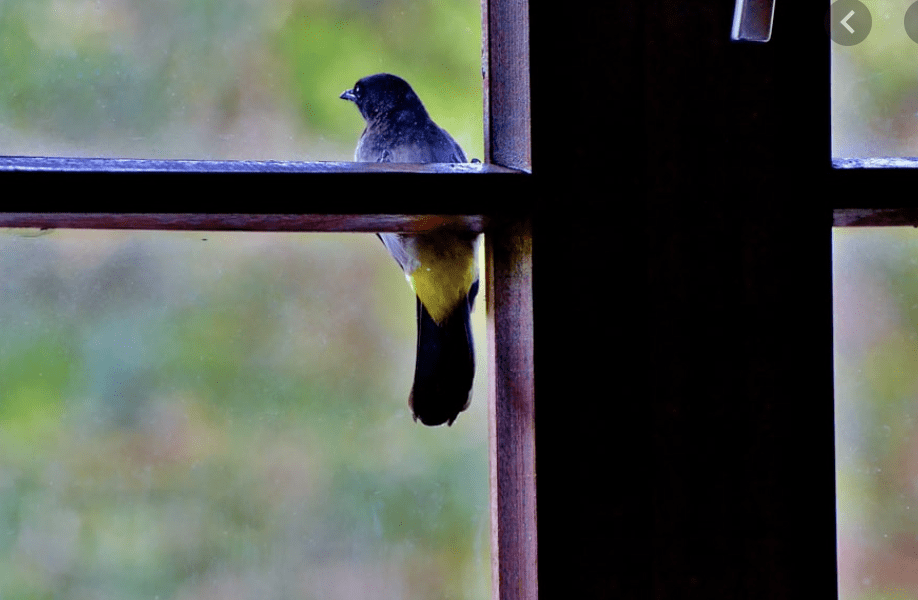
by Pigeon Patrol | Dec 27, 2020 | 4-S Gel Bird repellent, Animal Deterrent Products, Bird Deterrent Products, Bird Netting, Bird Spikes, Pigeon Patrol's Services, Pigeon Spikes
What To Do About Birds That Get In Your House
Picture this: you’re sitting on your living room couch, reading a book or dozing off, when you suddenly hear the sound of flapping wings. Intrigued, you look around, only to see a sparrow, a Mockingbird, or some other non-domesticated bird perched inside your fireplace. You barely manage to say “What in the world…?!” (or something a little less polite) before the terrified critter takes flight and settles on top of your mantle or a wall-mounted kitchen cabinet.
So, now you have an avian intruder inside your house, and neither of you are particularly pleased to see each other.
What do you do?
Typically, when a bird winds up in a house via the chimney, it’s a direct result of either (1) the bird seeking out the warm/cold air that it senses emanating from the house and deciding to take shelter, or (2) the bird—especially if it’s only a fledgling—taking a tumble out of a nest that’s been built inside the chimney. In any case, while it’s really not a reason to panic or let your household descend into chaos, it is a situation that should be resolved as soon as possible!
What To Do About Birds That Get In Your House
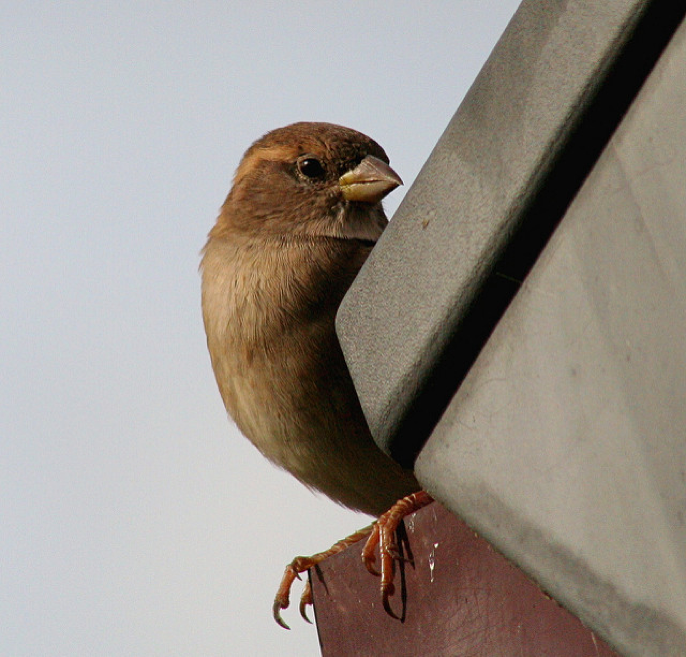
If a single bird “drops in” unexpectedly, there are a few steps you can take to try to resolve the problem yourself:
1. Shut all interior doors leading into (or out of) the room where the bird is, and remove all pets.
Modern houses tend to have open floor plans with fewer doors and walls, so isolating the bird to one room may be a little tricky. But at the very least, closing off the area will limit the space in which the bird can flee. Getting pets out of the way is for both their safety and the safety of the stray bird; while dogs and cats may be inclined to give chase, interactions with wild birds can lead to illnesses or injury for both parties.
2. In the “bird room,” open up a single door or window and cover up all the others.
Remove any screens and close any curtains (or put up sheets) as necessary. The point is to make the bird think that there’s only one way out of the room. Covering up the other windows and doors will also decrease the likelihood that the bird will fly into a glass barrier, injuring—or killing—itself in the process.
3. Give the bird time to leave on its own.
If you’re lucky, it will notice the exit you made and see itself out. In that case, be sure to close the door or window immediately after!
4. Use a sheet to help guide the bird out.
If the bird seems hopelessly confused and can’t find the exit, you can hold up a sheet with two hands and try to shepherd the bird in the right direction. You are not trying to capture the bird inside the sheet; you’re simply using it as a tool to direct the bird’s movement. Holding the sheet in front of your face during this attempt can help you protect yourself from scratches or pecks if the bird lashes out in fear.
5. Check the chimney.
Hopefully, the bird that’s currently in your house is acting alone. However, it’s also possible that there’s an entire nest of birds living inside the chimney and this episode is just the tip of the avian iceberg. So take a look (and a listen) inside your fireplace; if you have any suspicions that there are more birds lurking within the chimney, then you need to…
6. Call for help.
If your attempts to get the bird yourself have failed, you may need to call a professional wildlife removal service and have one of their technicians take care of things. It’s also a good idea to get a professional involved if the bird appears sick, injured, or too young to fly on its own, as it may need help beyond simply relocating it outside. And, of course, if peeking into the chimney reveals evidence of a whole nest of birds instead of just a single stray, you’ll want to get professional backup ASAP.
Bird Blocking
Dealing with a stray bird isn’t as complicated or nerve-racking as dealing with a colony of rats or an ornery skunk, but it’s still not a great situation in which to find yourself.
Fortunately, you can reduce your risk by taking some preventative measures:
1. Have a chimney cap installed.
Birds can’t enter your home through the chimney if they can’t get inside (or build their nests) inside the chimney in the first place. Thus, adding a chimney cap (or replacing your damaged cap) is probably the more effective way to keep out birds and other animals.
2. Make sure the rest of your house is bird-proofed.
The chimney isn’t the only way that a bird can enter your house; exhaust vents and small holes in your roof are also prime targets. If you didn’t actually see the stray bird come out of your fireplace, check your attic to see if there are more of them living on your property.
3. Put screens on your windows and doors.
It’s not unheard of for birds to simply fly inside homes using these pathways instead of going through the trouble of breaching the walls or chimney. Sturdy screen doors and windows are a good way to enjoy the mid-spring breeze while keeping out birds (and bugs, too). Having a barrier in front of glass panes can also help prevent birds from accidentally flying into them, as well.
Generally speaking, people don’t really “fear” birds the way they do other pest animals. For full-blown infestations involving multiple birds, or any situation in which you find yourself feeling like you’re in over your head, Chimney and Wildlife Specialists is only a phone call away!
SOURCE
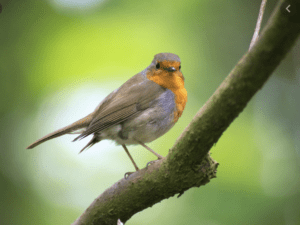
About Pigeon Patrol:
Pigeon Patrol Products & Services is the leading manufacturer and distributor of bird deterrent (control) products in Canada. Pigeon Patrol products have solved pest bird problems in industrial, commercial, and residential settings since 2000, by using safe and humane bird deterrents with only bird and animal friendly solutions. At Pigeon Patrol, we manufacture and offer a variety of bird deterrents, ranging from Ultra-flex Bird Spikes with UV protection, Bird Netting, 4-S Gel and the best Ultrasonic and audible sound devices on the market today.
Contact us at 1- 877– 4– NO-BIRD, (604) 585-9279 or visit our website at www.pigeonpatrol.ca
Pigeon / Pigeon Patrol / Pigeons Roosting Vancouver Pigeon Patrol / Bird Control / What To Do About Birds That Get In Your House Surrey Pigeon Control / Pest / Vancouver Pigeon Blog / Birds Inside Home / Pigeons in the cities / Ice Pigeons/ What to do about pigeons/ most common types of sparrows , Damages Caused by Sparrows, How To Keep Raccoons Away, de-fence, What To Do About Birds That Get In Your House What To Do About Birds That Get In Your House
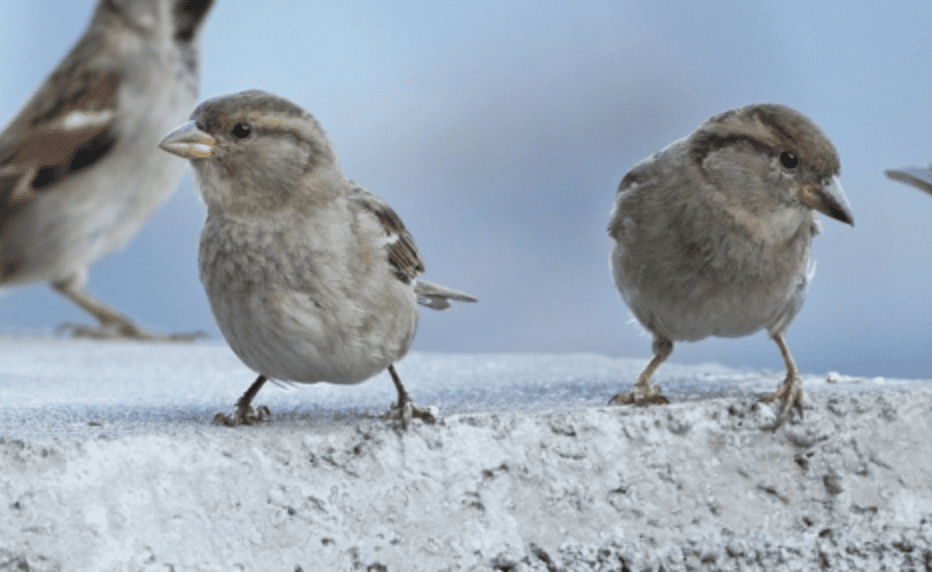
by Pigeon Patrol | Dec 7, 2020 | Bird Deterrent Products, Bird Netting, Bird Spikes, Pigeon Spikes, Pigeons in the News, Sparrows
Do Sparrow Cause Damage?
Damages Caused by Sparrows
- The sparrows are a host of some parasites and diseases. They are the source of dissemination of diseases like Chlamydiosis, Salmonellosis, Mycoplasma diseases, protozoal diseases and internal parasites like roundworms and tapeworms.
- Sparrows are recorded to possess bacterial pathogens which are common to humans like Salmonella and Escherichia coli. They serve as a reservoir host to transmit diseases to humans.
- They also host avian pox and avian malaria which spreads to the native birds.
- The sparrows are infested by a number of external parasites like mites, fleas or ticks.
- Localized damage to the grain fields can be done by sparrows as the feed in large numbers over a small area.
- Sparrows can damage the crops by feeding on seedlings, seeds, flowers and fruits.
- They interfere with the production of livestock especially poultry by contaminating their feed.
- Bird droppings can cause damage to the roofs as they are very acidic in nature. They may cause damage to the machinery like air conditioner equipment’s, industrial machinery and may pose a health risk to workers. They also pose dangerous health risks to workers.
- Bird droppings can ruin plastics, chemical, and liquids when they are being manufactured.
- They enter through broken or unsealed holes into the attics of houses, apartments, and buildings. They construct their nests in such places and ruin the whole area with their bodily wastes.
- Sparrow’s nests may cause blockage of the drainage systems along with damage to the roofs.
House sparrows consume grains in fields and in storage. Localized damage can be considerable since sparrows often feed in large numbers over a small area. Sparrows damage crops by pecking seeds, seedlings, buds, flowers, vegetables, and maturing fruits. They interfere with the production of livestock, particularly poultry, by consuming and contaminating feed.
Because they live in such close association with humans, they are a factor in the dissemination of diseases (chlamydiosis, coccidiosis, erysipeloid, Newcastle’s, parathypoid, pullorum, salmonellosis, transmissible gastroenteritis, tuberculosis, various encephalitis viruses, vibriosis, and yersinosis), internal parasites (acariasis, schistosomiasis, taeniasis, toxoplasmosis, and trichomoniasis), and household pests (bed bugs, carpet beetles, clothes moths, fleas, lice, mites, and ticks).
House sparrow droppings and feathers create janitorial problems, as well as hazardous, unsanitary, and odoriferous situations inside and outside of buildings and sidewalks under roosting areas.
Damage can also be caused by the pecking of rigid foam insulation inside buildings. The bulky, flammable nests of house sparrows are a potential fire hazard. The chattering of the flock on a roost is an annoyance to nearby human residents.
Habitat
The house sparrow is found in nearly every habitat except dense forests, alpine, and desert environments. Sparrows typically prefer human-altered habitats, particularly farm and grassy areas. It is the most common bird in most urban areas.
Food Habits
House sparrows are primarily granivorous. Plant materials (grain, fruit, seeds, and garden plants) make up 96% of the adult diet. The remainder consists of insects, earthworms, and other animal matter.
Garbage, bread crumbs, and refuse from fast-food restaurants can support sparrow populations in urban habitats.
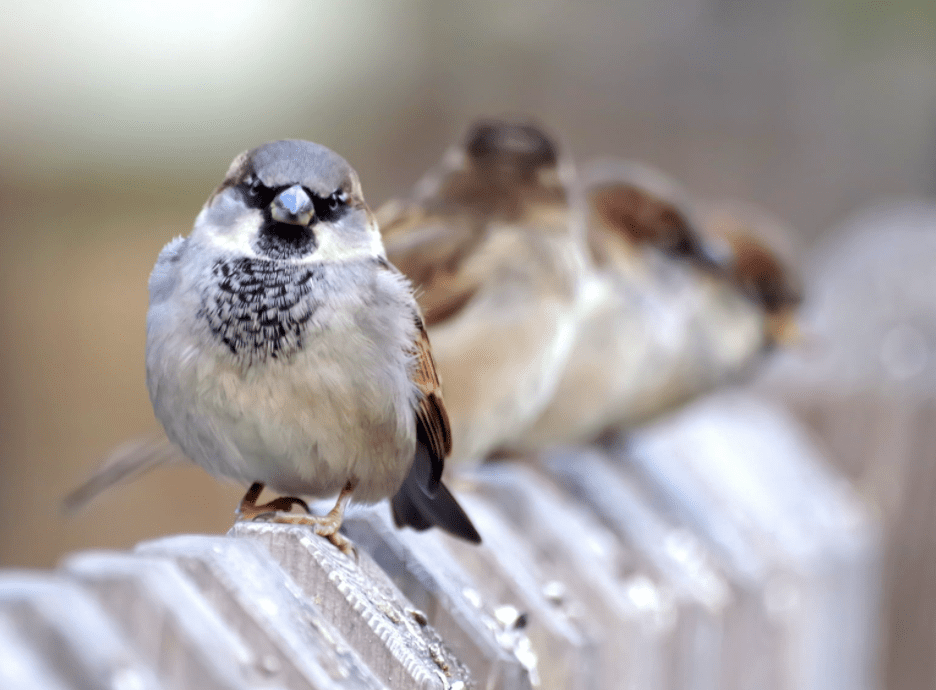
About Pigeon Patrol:
Pigeon Patrol Products & Services is the leading manufacturer and distributor of bird deterrent (control) products in Canada. Pigeon Patrol products have solved pest bird problems in industrial, commercial, and residential settings since 2000, by using safe and humane bird deterrents with only bird and animal friendly solutions. At Pigeon Patrol, we manufacture and offer a variety of bird deterrents, ranging from Ultra-flex Bird Spikes with UV protection, Bird Netting, 4-S Gel and the best Ultrasonic and audible sound devices on the market today.
Contact us at 1- 877– 4– NO-BIRD, (604) 585-9279 or visit our website at www.pigeonpatrol.ca
Pigeon / Pigeon Patrol / Pigeons Roosting / Vancouver Pigeon Patrol / Bird Control / Surrey Pigeon Control / Pest / Vancouver Pigeon Blog / Birds Inside Home / Pigeons in the cities / Ice Pigeons/ What to do about pigeons/ most common types of sparrows , Damages Caused by Sparrows





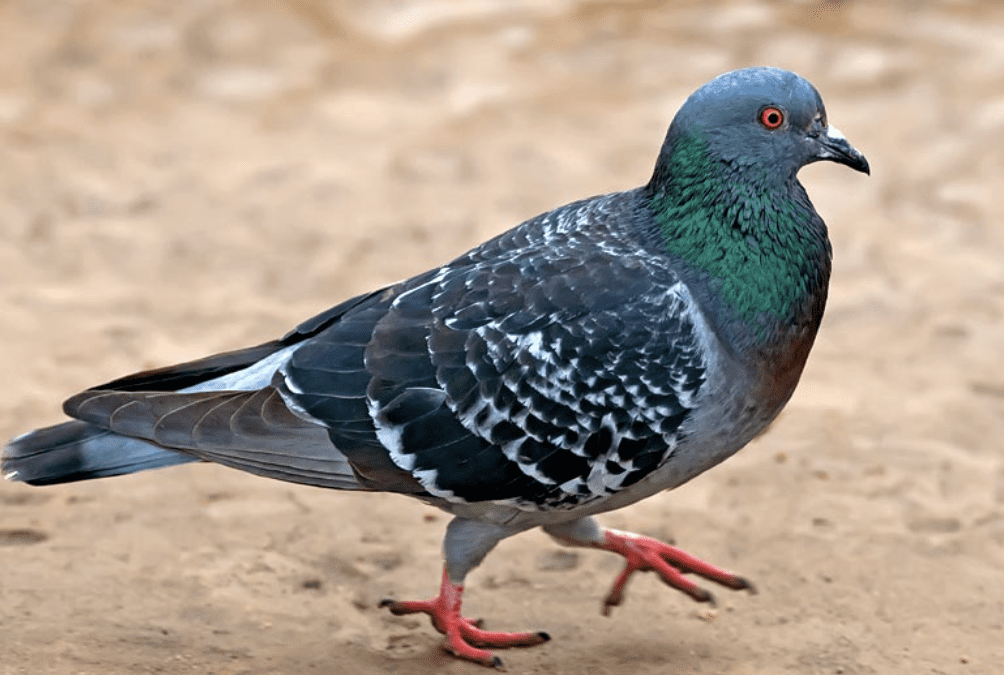
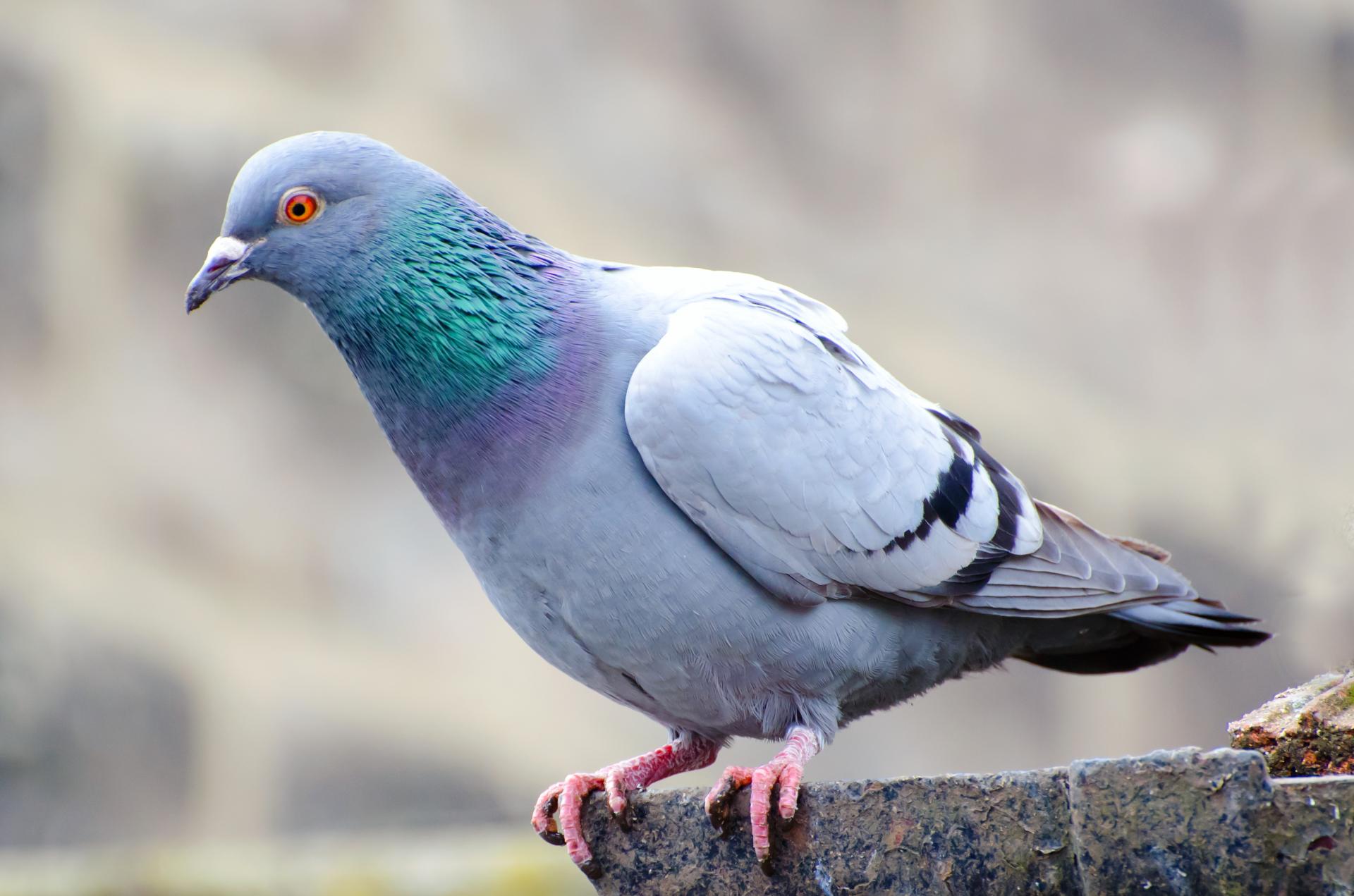
 About Pigeon Patrol:
About Pigeon Patrol:
 Widcombe Manor Farm Dovecote
Widcombe Manor Farm Dovecote
 Ancient Dovecote at Embleton
Ancient Dovecote at Embleton
 Much Marcle Dovecote
Much Marcle Dovecote
 Breeding Cubicles,
Breeding Cubicles, Cross-section of
Cross-section of Dovecote at Godminster
Dovecote at Godminster
 Dovecote at Weetwood Hall
Dovecote at Weetwood Hall
 Dovecote at Kings Pyon
Dovecote at Kings Pyon
 Bailiffscourt Dovecote
Bailiffscourt Dovecote

